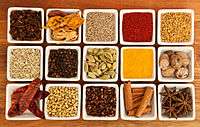Chikki
Chikki is a traditional Indian sweet (brittle) generally made from nuts and jaggery/sugar.[1] There are several different varieties of chikki in addition to the most common groundnut (peanut) chikki. Each variety of chikki is named after the ingredients used, which include puffed or roasted Bengal gram, sesame, puffed rice, beaten rice, or khobra (desiccated coconut), and other nuts such as almonds, cashews and pistachios.
 |
| This article is part of the series on |
| Indian cuisine |
|---|
|
Regional cuisines
|
|
Ingredients, types of food
|
|
See also
|
|
Related cuisines |
|
Peanut chikki | |
| Alternative names | Kappalandi Mittai |
|---|---|
| Type | Brittle |
| Course | Snack |
| Place of origin | India |
| Region or state | India, Pakistan, Bangladesh |
| Main ingredients | Peanuts, jaggery |
In regions of North India, especially Bihar and Uttar Pradesh, this sweet is called Layiya Patti. In Sindh and Sindhi regions of India, it is called Layee or Lai and in other north Indian states, it is also known as gajak or maroonda. In Bangladesh, it is known as gur badam. In South Indian states of Telangana and Andhra Pradesh, it is called Palli Patti. Similar dishes are also very popular in Brazil, where it is known as pé-de-moleque, and in Paraguay, where it is called Ka'í Ladrillo.
Ingredients

Some chikkis are made using a combination of ingredients. Special chikkis are made out of cashews, almonds, pistachios, and also sesame seed - called an ellu in Tamil. Though jaggery is the usual sweetener material, sugar is used as the base in certain types of chikkis. It is a very popular sweet item in both rural and urban South Asia (spanning India, Pakistan, Bangladesh, Nepal and Sri Lanka). Some also add glucose to the chikkis, which are usual there. It started from a single flavor of jaggery and peanuts. And today there are different exotic flavors such as strawberry, cranberry available in the market.
In the South Indian state of Tamil Nadu, the preparation is with a larger proportion of nuts to jaggery and the mixture is formed into balls and slabs. The most common versions are kadalai urundai (peanut balls), ellu urundai (sesame balls) and pori urundai (puffed rice balls). In Kerala, it is made in both slab and ball forms. Peanut based sweet is called as kadala mithai or kappalandi mithai or in some places as abhayaarthi katta . And the sesame based sweet is called as ellunda. Lonavla, the hill station in the Indian state of Maharashtra is synonymous with Chikki; no trip is complete without tourists picking up a few packets of their favourite chikki to take back home.
Preparation
The preparation of chikkis consists of first preparing the hot jaggery syrup with a minimum of water, adding nuts to the syrup to coat them (with the syrup) and then transferring the nuts to a wooden mould, then rolling them to a thickness of about 6–8 mm using a wooden roller, then placing into a steel plate for cooling, cutting into slabs, and packing. In homes, smaller quantities are hand rolled with wooden rollers.
Most popular chikkis are sourced from the Indian towns of Bhuj in Gujarat; Kovilpatti in Tamil Nadu; Lonavala, Matheran, Mahabaleshwar, Panchgani, and Karjat in Maharashtra.[2]
.jpg)
See also
- Gajak, a similar candy with sesame seeds
- Kovilpatti
- Lonavala chikki
- Peanut brittle, a similar candy with a lower proportion of nuts
- Gozinaki
- List of peanut dishes
- Tameletjie
- Alegría (Mexican candy)
- Pé-de-moleque
References
- Chitrodia, Rucha Biju. "A low-cal twist to sweet sensations". The Times of India. Retrieved 19 August 2012.
- Vaid, Molshree. "Chikki on a Sticky Wicket". The Times of India. Retrieved 19 August 2012.